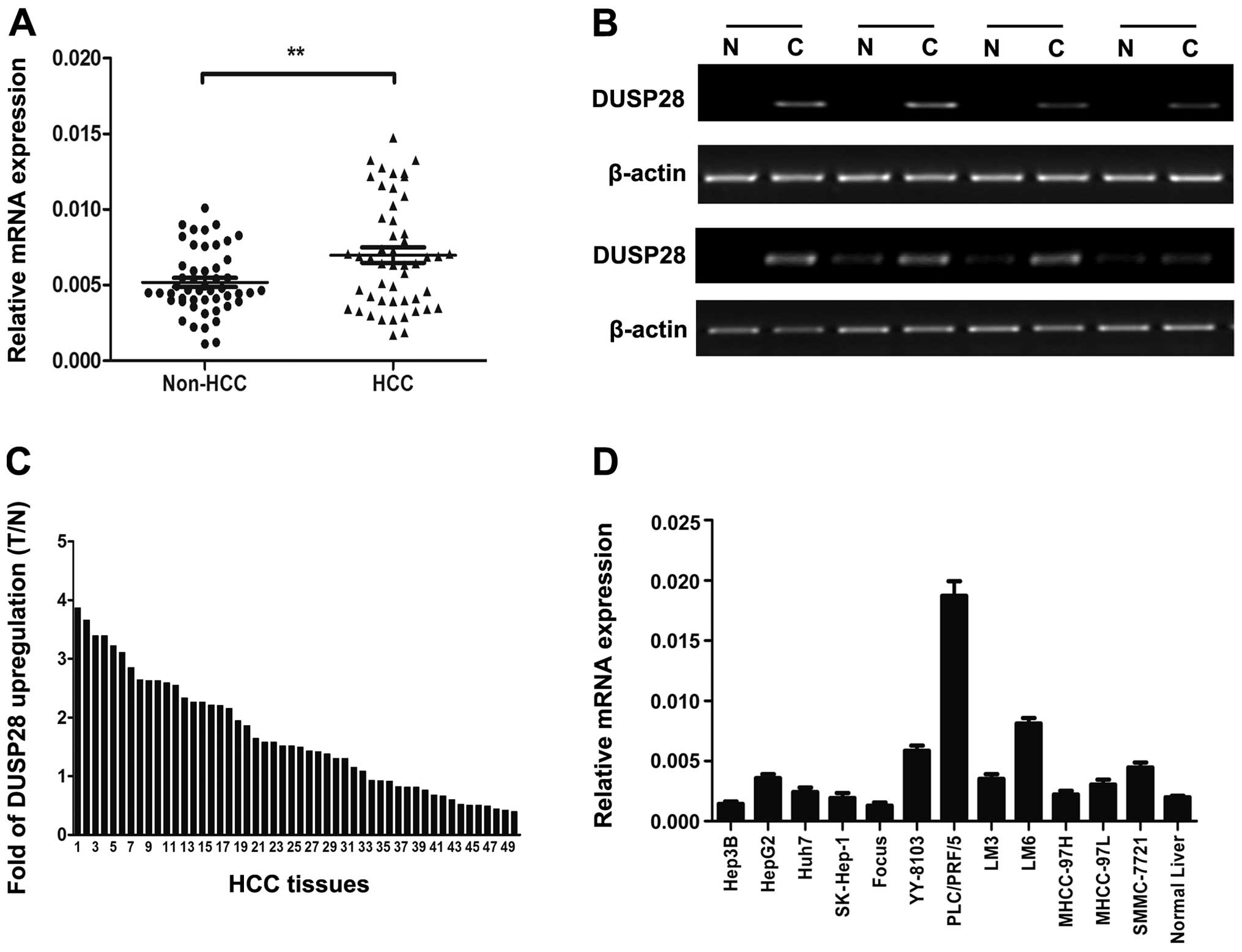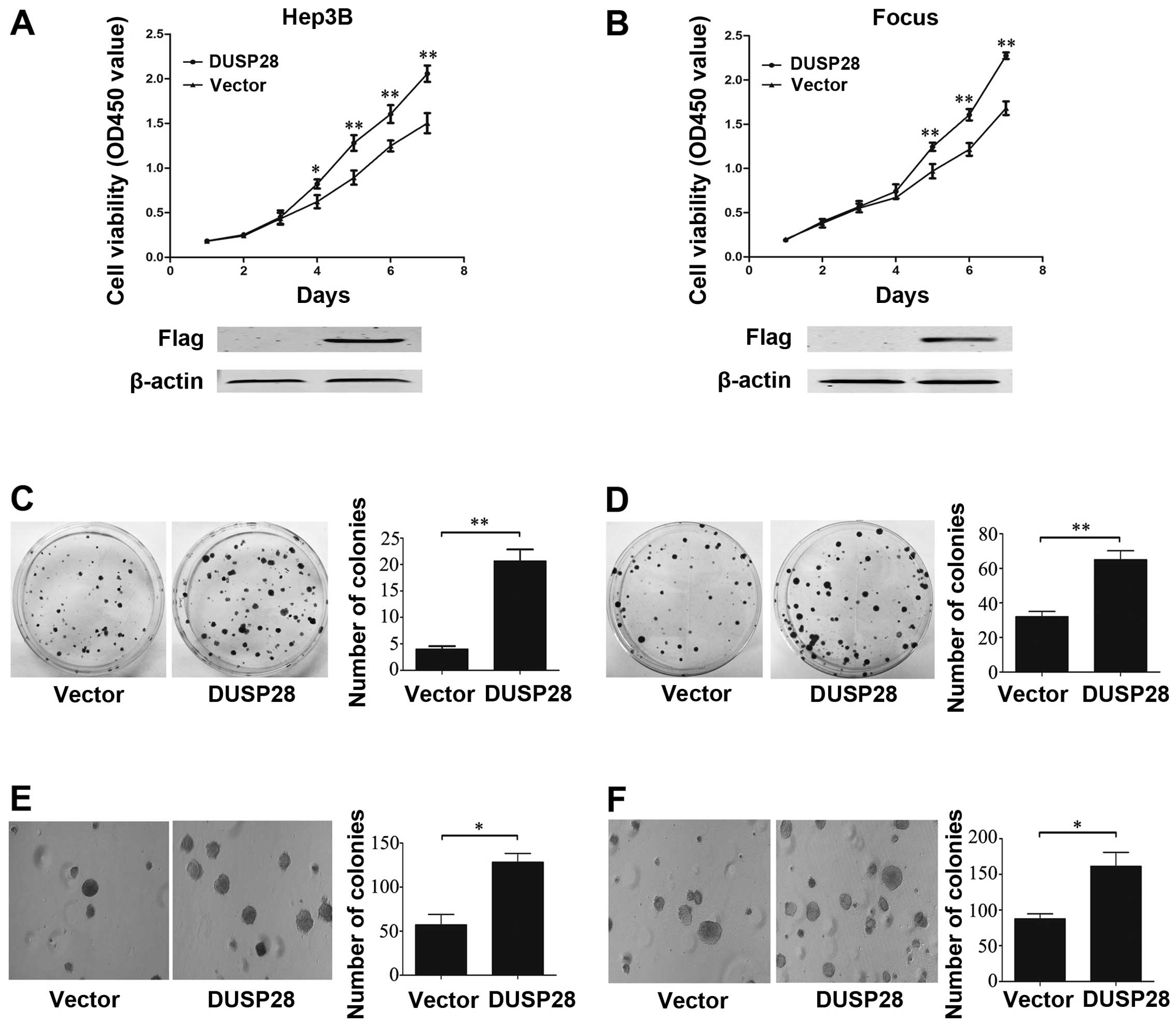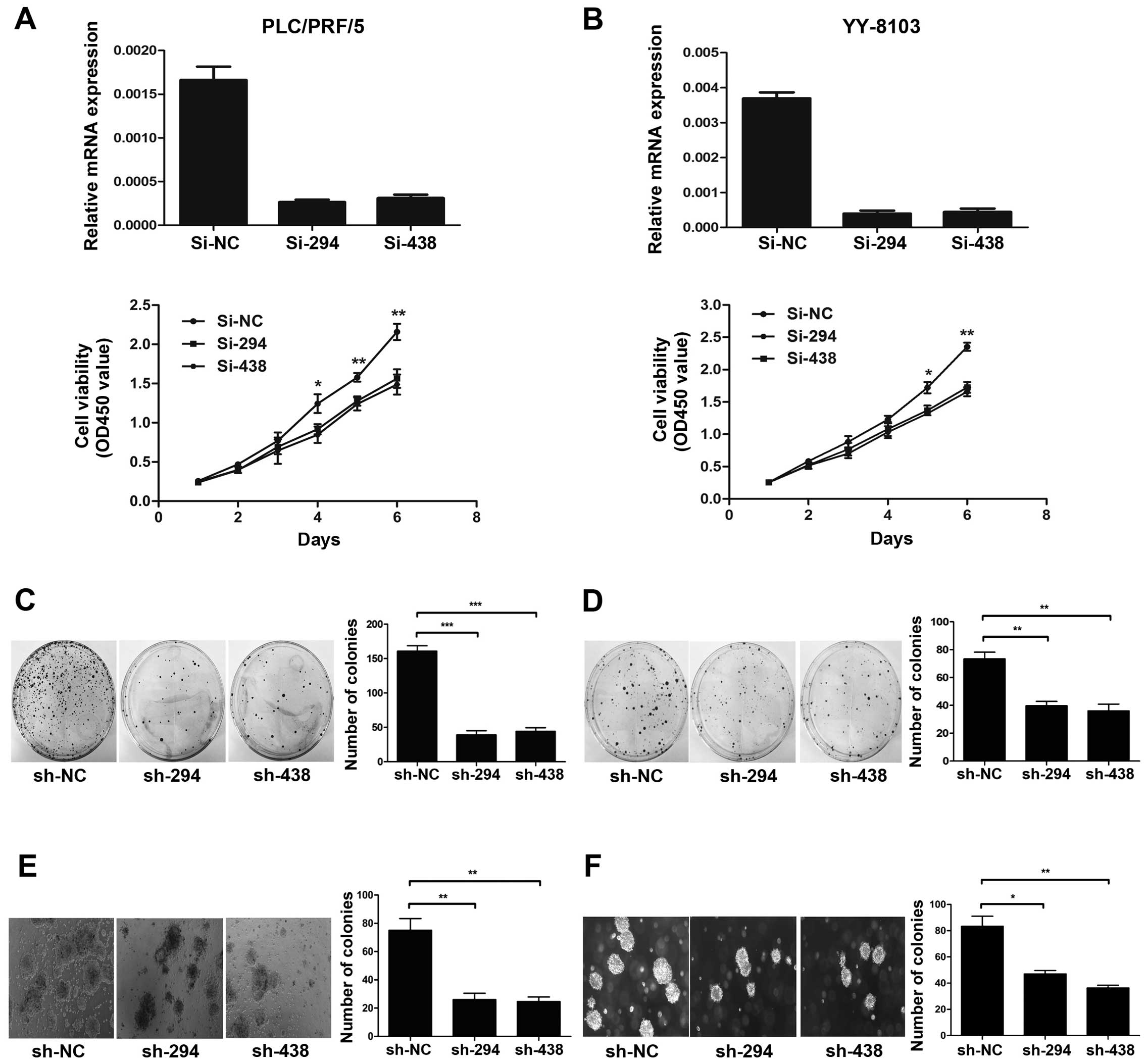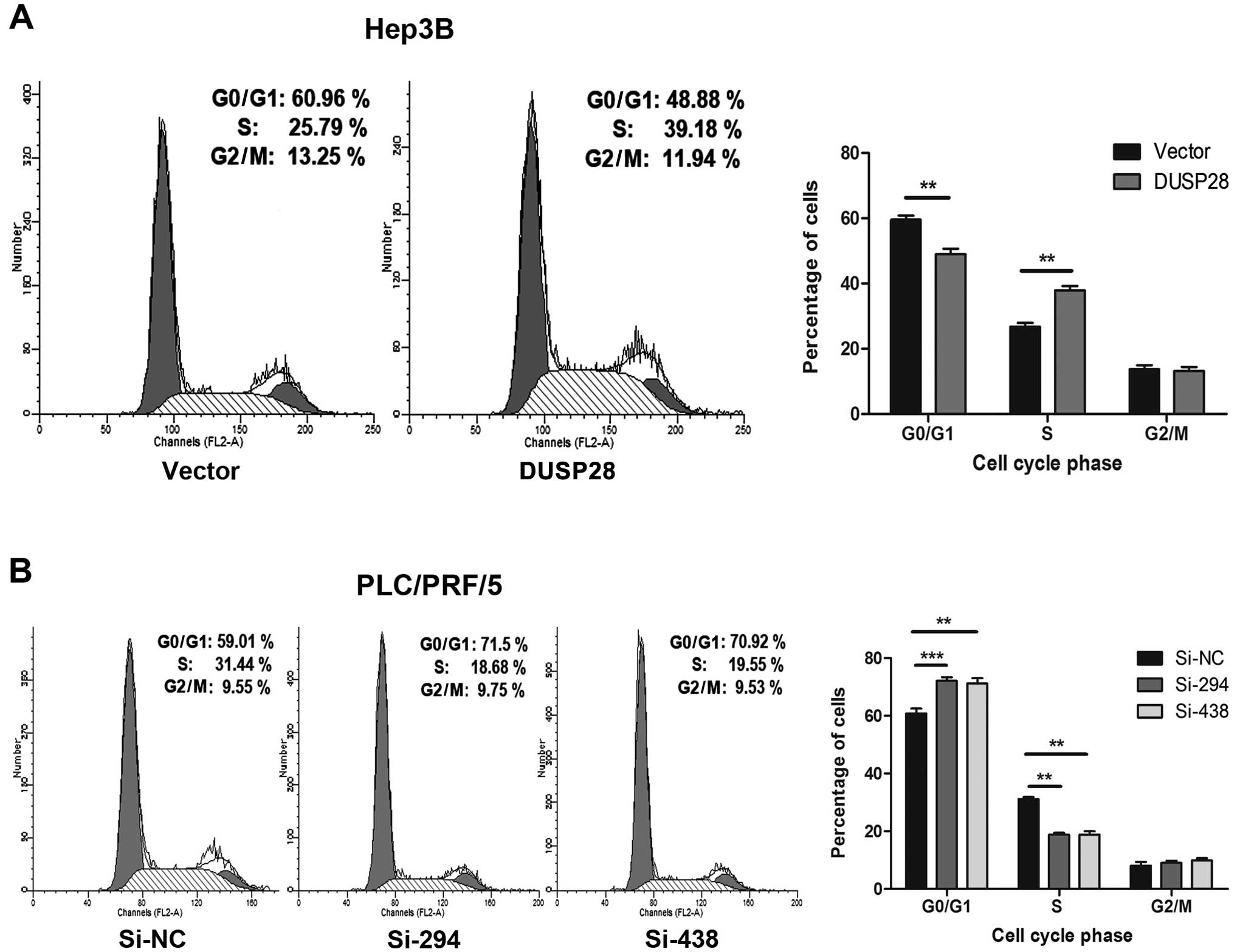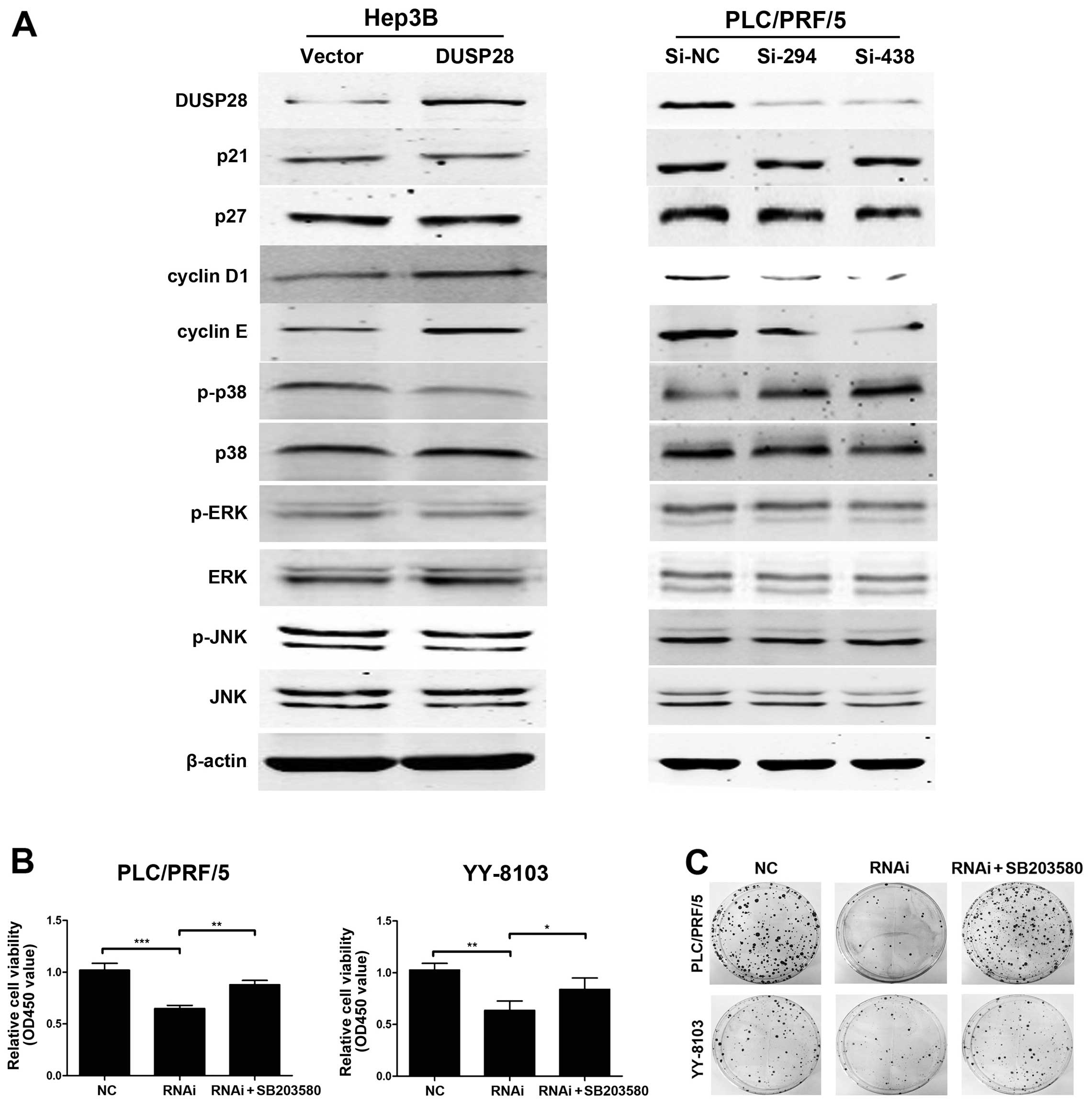DUSP28 contributes to human hepatocellular carcinoma via regulation of the p38 MAPK signaling
- Authors:
- Published online on: September 16, 2014 https://doi.org/10.3892/ijo.2014.2653
- Pages: 2596-2604
Abstract
Introduction
Liver cancer is the sixth most common malignant disease worldwide but the third most frequent cause of cancer-related death. Of these cases and deaths, approximately 50% are estimated to occur in China. As the major histological subtype, hepatocellular carcinoma (HCC) accounts for 70–85% of the total liver cancer incidence worldwide. Both the morbidity and mortality of HCC have increased during the past few decades and long-term prognosis and survival rate of HCC patients after surgical resection remain unsatisfactory because of the high rate of recurrence and metastasis (1,2–6). Hepatitis B or C viral infection, alcohol abuse and aflatoxin intake are the main known risk factors for the development of HCC, yet prevention and treatment of HCC require a better understanding of the molecular mechanisms underlying the oncogenesis and cancer progression of HCC (7–10).
Dual-specificity phosphatases (DUSPs) are a heterogeneous group of protein phosphatases that can regulate the activity of mitogen-activated protein kinases (MAPKs), which play a critical role in the control of cell growth and survival in physiological and pathological processes, including cancer (11,12). DUSPs can be classified into six major groups based on the presence of specific domains and sequence similarity, including the MAPK phosphatases (MKPs), as well as a group of small-size atypical DUSPs (13). As their name indicates, MKPs can dephosphorylate MAPK proteins ERK, JNK and p38 with specificity. The small-size atypical DUSPs are structurally and functionally related to the MKPs, although they lack the N-terminal regulatory domain. The MKPs and their alterations in cancer have been widely investigated, while the involvement of the small atypical DUSPs in cancer has been less studied (14–17). In the past, atypical DUSPs have gene rally been grouped together with the MKPs and characterized for their role in MAPK signaling cascades, however, growing number of investigations indicate that they can have vastly different substrate specificities and physiological roles from those of the typical MKPs (18–20). Some of these atypical DUSPs are emerging as potential regulators of cell growth and apoptosis and several small-sized atypical DUSPs have been directly related with human disease including cancer (21–23). The active role for atypical DUSPs in oncogenesis or resistance to cancer therapies makes them good candidate targets for anti-cancer drugs. To date, some atypical DUSPs are emerging as relevant targets for anti-cancer therapy and drug-discovery efforts are undertaking to develop specific and efficient DUSP enzyme inhibitors (24–27).
Despite previous studies that have been carried out in this area, the expression of DUSP28, a member of the small-size atypical DUSPs, is completely unknown in HCC. Our previous genome-wide approach demonstrated that DUSP28 was markedly upregulated in HCC clinical specimens compared to adjacent non-cancerous livers (data not shown). In this current study, we confirm that DUSP28 is frequently upregulated in HCC and can significantly promote HCC cell proliferation and colony formation in vitro. Further analysis reveals the potential role of DUSP28 on HCC cell cycle transition. We indicate for the first time that DUSP28 plays a critical role in HCC progression and may serve as a candidate therapeutic target for HCC.
Materials and methods
Tissue samples
In this study, we collected 50 pairs of clinical tissue samples from the First Affiliated Hospital of Nanjing Medical University between January 2004 and May 2006. All the tissue specimens, both cancerous and non-cancerous, were obtained from resected specimens and were then rapidly frozen at −80°C for storage until use. The diagnosis of HCC was validated by pathological examination. Written informed consent was obtained from all patients and the study was approved by the institutional ethics committee of Nanjing Medical University.
Cell lines and culture conditions
The human HCC cell lines (Hep3B, HepG2, Huh7, SK-Hep-1, Focus, YY-8103, PLC/PRF/5, LM3, LM6, MHCC-97H, MHCC-97L, SMMC-7721) used in this study were obtained from the Chinese National Human Genome Center at Shanghai. Each was cultured at 37°C, 95% air, 5% CO2 in Dulbecco’s modified Eagle’s medium (DMEM) containing 10% fetal bovine serum (FBS) (both from HyClone, Logan, UT, USA), 50 U/ml penicillin and 50 μg/ml streptomycin.
Antibodies and reagents
Antibodies against Flag, DUSP2, cyclin D1, cyclin E, p21, p27, and β-actin were from Santa Cruz Biotechnology, Inc. (Santa Cruz, CA, USA). Antibodies against ERK (total), ERK (phosphorylated Thr202/Tyr204), JNK (total), JNK (phosphorylated Thr183/Tyr185), p38 (total), p38 (phosphorylated Thr180/Tyr182) were obtained from Cell Signaling Technology, Inc. (Danvers, MA, USA). SB203580 was purchased from Sigma (St. Louis, MO, USA).
RNA extraction, semi-quantitative and real-time PCR
Total RNA was extracted with TRIzol® (Invitrogen Life Technologies, Carlsbad, CA, USA), following the manufacturer’s protocol. Reverse transcription was performed in a 25-μl reaction volume using M-MLV Reverse Transcriptase (Promega Corporation, Madison, WI, USA) with a total of 2 μg of RNA. Semi-quantitative RT-PCR was performed and products were separated on 1% agarose gel-containing ethidium bromide. Quantitative real-time PCR was performed using a Thermal Cycler Dice Detection System with the SYBR Premix Ex Taq™ (Perfect Real-Time) (Takara Bio, Inc., Shiga, Japan). The sequences of primers specific to DUSP28 and housekeeping genes were designed as follows: DUSP28 forward, 5′-CCTTCCAGATGGTGAAGAGC-3′ and reverse, 5′-GGTGAATGTGGGTGACACTG-3′; β-actin forward, 5′-AGAGCCTCGCCTTTGCCGATCC-3′ and reverse, 5′-CTGGGCCTCGTCGCCCACATA-3′.
Protein extraction and western blot analysis
Total cellular proteins were extracted using cell lysis buffer containing 50 mM Tris-HCl (pH 6.8), 2% SDS, 10% 2-mercaptoethanol, 10% glycerol, and protease inhibitor cocktail (Sigma). Then protein concentration was determined using a BCA kit (Thermo Fisher Scientific, Waltham, MA, USA). The protein (20 μg) was subjected to electrophoresis by SDS-PAGE on a 10% gel and then transferred to a polyvinylidene difluoride (PVDF) membrane. The membrane was blocked with 5% non-fat dry milk and 0.1% Tween-20 in PBS for 2 h at room temperature. After incubation with the appropriate primary antibody overnight at 4°C, membranes were washed and incubated with the IRDye 800CW or 680RD secondary antibodies in TBST for 2 h at room temperature. The labeled protein bands were detected using the Odyssey Infrared Imaging System (Li-COR Biosciences, Lincoln, NE, USA). β-actin was used as a loading control.
Plasmid construction
The full-length DUSP28 open reading frame (ORF) was amplified from the cDNA of PLC/PRF/5 cell using PrimeStar PCR and then the product was inserted into the expression vector pcDNA3.1B-FLAG-GFP, obtained from the Chinese National Human Genome Centre at Shanghai. The sequences of the cloning primers were as follows: DUSP28-XhoI forward, 5′-TACTCGAGATGGGACCGGCAGAAGCTGGGCGCCG-3′; DUSP28-BamHI reverse, 5′-GAGGATCCAGCCTCAGGGCCCAACCCTAAGGCTG-3′.
RNA interference
Two siRNAs against DUSP28 were chemically synthesized (Shanghai GenePharma Co., Shanghai, China) and their sequences are as follows: siRNA-294 forward, 5′-CUGCCUAGUCUACUGCAAGAACGdTdT-3′ and reverse, 5′-CGUUCUUGCAGUAGACUAGGCAGdTdT-3′; siRNA-438 forward, 5′-CUGGUCUCAGCUCCAGAAGUAUGdTdT-3′ and reverse, 5′-CAUACUUCUGGAGCUGAGACCAGdTdT-3′. The non-targeting nucleotides were used as a negative control: siRNA-NC forward, 5′-UUCUCCGAACGUGUCACGUdTdT-3′ and reverse, 5′-ACGUGACACGUUCGGAGAAdTdT-3′. The oligonucleotides encoding short hairpin RNAs (shRNAs) for the continuous knockdown of endogenous DUSP28 were synthesised and inserted into pSUPER (OligoEngine, Seattle, WA, USA). Their sequences are as follows: shRNA-294 forward, 5′-GATCCCCCTGCCTAGTCTACTGCAAGAACGTTCAAGAGACGTTCTTGCAGTAGACTAGGCAGTTTTTGGAAA-3′ and reverse, 5′-AGCTTTTCCAAAAACTGCCTAGTCTACTGCAAGAACGTCTCTTGAACGTTCTTGCAGT AGACTAGGCAGGGG-3′; shRNA-438 forward, 5′-GATCCCCCTGGTCTCAGCTCCAGAAGTATGTTCAAGAGACATA CTTCTGGAGCTGAGACCAGTTTTTGGAAA-3′ and re verse, 5′-AGCTTTTCCAAAAACTGGTCTCAGCTCCAGAAGTATGTCTCTTGAACATACTTCTGGAGCTGAGACCAGGGG-3′; shRNA-NC contained irrelevant nucleotides and served as a negative control: shRNA-NC forward, 5′-GATCCCCTTCTCCGAACGTGTCACGTTTCAAGAGAACGTGACACGTTCGGAGAATTTTTGGAAA-3′ and reverse, 5′-AGCTTTTCCAAAAATTCTCGAACGTGTCACGTTCTCTTGAAACGTGACACGTTCGGAGAAGGG-3′.
Cell transfection
Cell transfection was performed with Lipofectamine 2000 (Invitrogen Life Technologies) according to the manufacturer’s instructions. Cells were transfected with RNAi and plasmid at cell density of 30–50% and 80–90%, respectively.
Cell proliferation
Transiently transfected HCC cells were plated at a density of 2,000–5,000 cells/well into 96-well plates and cultured for 6 days or 7 days. Cell growth was examined using the Cell Counting kit-8 (Dojindo Laboratories, Kumamoto, Japan) according to the manufacturer’s instructions. The absorbance value at a wavelength of 450 nm was used as an indicator of cell viability.
Colony formation
HCC cells were transfected and then plated at a density of 10,000–50,000 cells/10-cm plate. Then G418 (Life Technologies, Grand Island, NY, USA) was added to the medium at a final concentration of 0.8–1 mg/ml for colony formation at 37°C in 5% CO2. After 2–3 weeks of selection, the remaining colonies were washed twice with PBS, fixed with paraformaldehyde and stained with Coomassie brilliant blue.
For the soft agar colony formation assay in 24-well plates, 2,000–5,000 transfected cells were plated and grown on a plate containing 1% base agar and 0.5% top agar. After cultured for 3–4 weeks, all colonies were photographed and counted under a dissecting microscope.
Cell cycle analysis
Flow cytometry was performed to analyse the cell cycle. Serum starvation was used to induce cell cycle synchronization before cells were transfected with siRNA or plasmid and then harvested as single cell suspensions. For DNA content detection, cells were fixed in 70% ethanol, resuspended in PBS, incubated with RNase A (10 mg/ml) and propidium iodide (10 μg/ml) for 30 min in the dark, followed by flow cytometric analysis using the FACSCalibur flow cytometer, CellQuest (BD Biosciences, Franklin Lakes, NJ, USA).
Statistical analysis
Statistical analysis was performed by Student’s t-test using GraphPad Prism 5 software. All results are presented as means ± standard deviation (SD). P<0.05 was considered to be statistically significant.
Results
Expression level of DUSP28 is significantly upregulated in HCC
We first examined expression levels of DUSP28 in 50 paired HCC tissues by quantitative real-time PCR and semi-quantitative RT-PCR. The results showed that DUSP28 mRNA expression was significantly upregulated in the HCC tissues in comparison with the corresponding adjacent non-cancerous livers (Fig. 1A and B). Among these samples, DUSP28 was shown to be elevated in 15/50 (30%) of the HCC specimens at >2-fold higher levels (Fig. 1C). Moreover, DUSP28 expression levels were assessed in set of 12 widely-used HCC cell lines and we found that the expression of DUSP28 was higher in a majority of HCC cell lines when compared to normal adult liver tissue (Fig. 1D).
Overexpression of DUSP28 promotes HCC cell proliferation and colony formation in vitro
To evaluate the role of DUSP28 in HCC, we first observed the effect of DUSP28 overexpression on HCC cells. So we transiently transfected the recombinant plasmid pcDNA3.1-DUSP28 into Hep3B and Focus cell lines, which lack endogenous DUSP28 expression. The empty pcDNA3.1 vector was used as control. Western blot analysis was performed to confirm that the transfected DUSP28 was expressed successfully in Hep3B and Focus cells. Our observation revealed that DUSP28 overexpression significantly promoted cell growth (Fig. 2A and B) and colony formation (Fig. 2C and D) when compared to that of the cells transfected with the empty vector. Moreover, ectopic DUSP28 expression significantly enhanced the anchorage-independent growth of Hep3B and Focus cell lines in soft agar, as well as dramatically increased the number of larger colonies relative to the cells transfected with the empty vector (Fig. 2E and F). These data suggest that DUSP28 overexpression plays an important role in promoting cell proliferation, anchorage-dependent and -independent colony formation in vitro.
Knockdown of DUSP28 inhibits HCC cell proliferation and colony formation in vitro
To further investigate the role of DUSP28 on cell proliferation and colony formation, we used chemically synthesised siRNAs (si-294 and si-438) to knock down endogenous DUSP28 in PLC/PRF/5 and YY-8103 cells with relatively high expression of DUSP28. The si-NC was used as a negative control. As expected, both siRNAs were considered to be effective for DUSP28 knockdown and were used subsequently. Cell proliferation assay showed that the siRNAs-transfected cells exhibited significant growth suppression in comparison with the si-NC-transfected cells (Fig. 3A and B). In order to examine the effect of DUSP28 on colony formation, we constructed the corresponding shRNA plasmids (pSUPER-sh-NC, pSUPER-sh-294 and pSUPER-sh-438) and transfected them to the same HCC cell lines. Results certified that both shRNAs significantly inhibited the colony formation of PLC/PRF/5 and YY-8103 cells compared to the control shRNA-NC-transfected cells (Fig. 3C and D). Furthermore, the downregulation of DUSP28 restrained the anchorage-independent colony formation of PLC/PRF/5 and YY-8103 cell lines in soft agar and significantly reduced the number of larger colonies compared to the cells transfected with the negative control shRNA (Fig. 3E and F). These collective data indicate that endogenous DUSP28 knockdown can significantly suppress cell growth, colony formation and soft agar colony formation in HCC cells.
DUSP28 influences the G1/S cell cycle transition
The fact that DUSP28 affects cell proliferation suggested that it may influence the cell cycle. Therefore, we performed a flow cytometric analysis and determined whether DUSP28 could affect cell cycle distribution. The results showed that the proportion of cancer cells at the G0/G1 phase was significantly decreased in Hep3B cells transfected with recombinant pcDNA3.1-DUSP28 plasmid than in those treated with empty pcDNA3.1 vector, while the proportion in S phase was remarkably increased (Fig. 4A). In contrast, the fraction of cancer cells at the G0/G1 phase was significantly increased upon DUSP28 downregulation with si-294 or si-438 in PLC/PRF/5 cells than in those treated with the control si-NC, while the proportion in S phase was notably decreased (Fig. 4B). In conclusion, these results suggest that DUSP28 plays an essential role in the growth regulation of HCC cells by modulating the G1/S transition.
DUSP28 regulates the p38 MAPK signaling pathway
To further clarify the mechanism by which DUSP28 affects the G1/S transition, western blot analysis was used to assay several key molecules including p27, p21, cyclin D1 and cyclin E, which are known to be involved in G1/S transition. Interestingly, our data showed that DUSP28 overexpression led to an increase of cyclin D1 and cyclin E in pcDNA3.1-DUSP28-infected Hep3B cells when compared with that of the cells transfected the empty vector, although no obvious changes were seen on p21 and p27 expression. In contrast, the opposite results were obtained when PLC/PRF/5 cells were infected with si-294 or si-438, supporting the observation of DUSP28 knockdown-mediated G1 arrest. Previous studies demonstrated that p38 MAPK activation could reduce the levels of cyclin D1, thus contributing to the induction of the G1/S checkpoint. Moreover, increasing evidence suggest that p38 MAPK can function as a suppressor of cell proliferation and tumorigenesis (28,29). Therefore, we proposed that DUSP28 might also be involved in the p38 MAPK signaling pathway. As confirmation, we assessed the levels of phosphorylated p38, as well as ERK1/2 and JNK, which are the classical MAPKs. Expectedly, the phosphorylation level of p38 was decreased in Hep3B cells transfected with pcDNA3.1-DUSP28 and increased in PLC/PRF/5 cells treated with si-294 or si-438. However, the phosphorylation level of ERK1/2 and JNK, was not observably changed (Fig. 5A). To further confirm the association between DUSP28 and p38, we used SB203580, a known p38 MAPK inhibitor, to determine whether p38 MAPK contributes to the phenotypic changes of DUSP28 knockdown in HCC cells. The result showed that p38 inhibitor SB203580 almost completely abolished the inhibitory the role of DUSP28 knockdown in PLC/PRF/5 and YY-8103 cells (Fig. 5B and C). Therefore, we infer that DUSP28 is involved in the activation of p38 MAPK signaling.
Discussion
HCC is one of the most prevalent malignancies, ranking as the sixth most common cancer worldwide and the third most common cause of cancer mortality. The prognosis of HCC patients remains very poor, so novel therapeutic approaches against drug targets are urgently needed (1,30).
The DUSPs constitute a heterogeneous group of cysteine-based protein tyrosine phosphatases. As a subgroup of DUSPs, the small-size atypical DUSPs are generally smaller and lack the CH2 domain in the N-terminus that is common to the typical MKPs (13). A number of studies on small atypical DUSPs in the past few decades has enhanced our understanding of their function in cancer and indicated their potential as anti-cancer therapy targets. For example, upregulation of DUSP3 is detected in some human carcinomas, including prostate and cervix carcinomas and it may act as a positive regulator of cell growth in cancer cells. Thus, inhibitors of the activity of DUSP3 could be putative anti-cancer drugs (31,32); DUSP23 is upregulated in several human cancers, and it promotes cell proliferation of human breast cancer cells by regulating the G1/S transition, suggesting a carcinogenic role for DUSP23, which makes it a promising drug target for anti-cancer therapy (33). Moreover, a recent study demonstrates that DUSP21 is upregulated in HCC specimens and the DUSP21 expression in HCC cells is essential for maintaining cell proliferation and survival, making DUSP21 a potential therapeutic target for HCC treatment (34). Besides, several other small atypical DUSPs, including DUSP14 and DUSP26, are also involved in cancer, raising the possibility of them as targets for drug discovery (35,36). Nevertheless, functional studies on some other small atypical DUSPs, such as DUSP13b, DUSP18 and DUSP28, are limited, and their relation with cancer especially HCC has not been confirmed. Due to their similarity in structure with the small atypical DUSPs mentioned above, it is possible that they may also play a role in cancer progression.
In this study, we pay particular attention to DUSP28, a member of the atypical DUSP family. Our previous gene-expression profiles using the genome-wide method indicated that DUSP28 was upregulated in HCC tissues compared with the matched non-tumorous tissues (unpublished data). Therefore, we suppose that DUSP28 may act as a possible oncogene in HCC. To confirm this assumption, we evaluate the expression levels of DUSP28 in additional 50 paired HCC samples and 12 HCC cell lines. Our data indicated that DUSP28 was frequently upregulated in human HCC tissues relative to matched non-tumorous samples. Besides, high expression of DUSP28 was also found in HCC cell lines. These data implied that DUSP28 might play a specific functional role in HCC carcinogenesis. Then we further investigated the function of DUSP28 in HCC cell proliferation in vitro. As expected, in vitro experiments revealed that DUSP28 overexpression accelerated the proliferation and colony formation of HCC cells, while DUSP28 knockdown led to a suppression of cell growth. Flow cytometric analysis indicated that over expression of DUSP28 facilitated the G1/S transition in Hep3B cells. Likewise, knockdown of DUSP28 in PLC/PRF/5 cells led to an arrest in G0/G1 phase.
In an attempt to explore the molecular mechanisms involved in the functions of DUSP28, western blot analysis was performed to detect several important molecules which are known to be involved in G1/S transition. We observed a significant increase of cyclin D1 and cyclin E in cells transfected with pcDNA3.1-DUSP28 plasmids, as well as an evident decrease of cyclin D1 and cyclin E in cells with DUSP28 knockdown. Accumulated evidence suggests that cyclin D1 and cyclin E are responsible for cell cycle progression from G1 to S phase (37), and that p38 activity can downregulate cyclin D1 expression, thus acting on cell cycle checkpoints (28). The role of the p38 MAPK pathway in the cell differentiation, growth inhibition and apoptosis is well documented and p38 MAPK has been defined as a tumor suppressor (38,39). Therefore, we subsequently detected the phosphorylation level of p38 in HCC cells. As expected, forced DUSP28 expression resulted in a decreased phosphorylation level of p38 in HCC cells, while DUSP28 knockdown led to an increased phosphorylation level of p38. Intriguingly, we did not observe obvious change on the phosphorylation level of ERK and JNK, although they are also possible substrates of DUSPs, indicating that DUSP28 might have a high substrate specificity for p38. In addition, to further confirm our observation, we used a known p38 MAPK inhibitor SB203580 in the cell proliferation assay. As expected, the anti-proliferative effect of DUSP28 knockdown in PLC/PRF/5 cells was significantly rescued by the p38 inhibitor SB203580.
To sum up, our study shows significant upregulation of DUSP28 in HCC tissues and cell lines. Ectopic expression of DUSP28 promotes cell proliferation, colony formation, soft agar colony formation of Hep3B and Focus cells, while knockdown of DUSP28 has the anti-proliferative effect in PLC/PRF/5 and YY-8103 cells. Further molecular-mechanism investigations clarified that DUSP28 was involved in the G1/S transition through the activation of p38 MAPK signaling. These data suggest that DUSP28 plays a significant role in HCC progression and targeting this molecule may be a potential novel therapeutic strategy for HCC treatment.
Acknowledgements
This study was supported by the National Natural Science Foundation, China (grant no. 81170415).
References
|
Jemal A, Bray F, Center MM, Ferlay J, Ward E and Forman D: Global cancer statistics. CA Cancer J Clin. 61:69–90. 2011. View Article : Google Scholar | |
|
Shiraha H, Yamamoto K and Namba M: Human hepatocyte carcinogenesis (review). Int J Oncol. 42:1133–1138. 2013.PubMed/NCBI | |
|
Perz JF, Armstrong GL, Farrington LA, Hutin YJ and Bell BP: The contributions of hepatitis B virus and hepatitis C virus infections to cirrhosis and primary liver cancer worldwide. J Hepatol. 45:529–538. 2006. View Article : Google Scholar : PubMed/NCBI | |
|
Yang Y, Nagano H, Ota H, et al: Patterns and clinicopathologic features of extrahepatic recurrence of hepatocellular carcinoma after curative resection. Surgery. 141:196–202. 2007. View Article : Google Scholar : PubMed/NCBI | |
|
Hwang S, Moon DB and Lee SG: Liver transplantation and conventional surgery for advanced hepatocellular carcinoma. Transplant Int. 23:723–727. 2010. View Article : Google Scholar | |
|
Abdel-Wahab M, Sultan AM, Fathy OM, et al: Factors affecting recurrence and survival after living donor liver transplantation for hepatocellular carcinoma. Hepatogastroenterology. 60:1847–1853. 2013.PubMed/NCBI | |
|
Sandhu DS, Baichoo E and Roberts LR: Fibroblast growth factor signaling in liver carcinogenesis. Hepatology. 59:1166–1173. 2014. View Article : Google Scholar : PubMed/NCBI | |
|
Guégan JP, Ezan F, Théret N, Langouët S and Baffet G: MAPK signaling in cisplatin-induced death: predominant role of ERK1 over ERK2 in human hepatocellular carcinoma cells. Carcinogenesis. 34:38–47. 2013.PubMed/NCBI | |
|
Fuchs BC, Hoshida Y, Fujii T, et al: Epidermal growth factor receptor inhibition attenuates liver fibrosis and development of hepatocellular carcinoma. Hepatology. 59:1577–1590. 2014. View Article : Google Scholar : PubMed/NCBI | |
|
Gao W, Kim H, Feng M, et al: Inactivation of Wnt signaling by a human antibody that recognizes the heparan sulfate chains of glypican-3 for liver cancer therapy. Hepatology. 60:576–587. 2014. View Article : Google Scholar : PubMed/NCBI | |
|
Dhillon AS, Hagan S, Rath O and Kolch W: MAP kinase signalling pathways in cancer. Oncogene. 26:3279–3290. 2007. View Article : Google Scholar : PubMed/NCBI | |
|
Kim EK and Choi EJ: Pathological roles of MAPK signaling pathways in human diseases. Biochim Biophys Acta. 1802:396–405. 2010. View Article : Google Scholar : PubMed/NCBI | |
|
Jeong DG, Wei CH, Ku B, et al: The family-wide structure and function of human dual-specificity protein phosphatases. Acta Crystallogr D Biol Crystallogr. 70:421–435. 2014. View Article : Google Scholar : PubMed/NCBI | |
|
Wu GS: Role of mitogen-activated protein kinase phosphatases (MKPs) in cancer. Cancer Metastasis Rev. 26:579–585. 2007. View Article : Google Scholar : PubMed/NCBI | |
|
Keyse SM: Dual-specificity MAP kinase phosphatases (MKPs) and cancer. Cancer Metastasis Rev. 27:253–261. 2008. View Article : Google Scholar : PubMed/NCBI | |
|
Haagenson KK and Wu GS: Mitogen activated protein kinase phosphatases and cancer. Cancer Biol Ther. 9:337–340. 2010. View Article : Google Scholar : PubMed/NCBI | |
|
Haagenson KK and Wu GS: The role of MAP kinases and MAP kinase phosphatase-1 in resistance to breast cancer treatment. Cancer Metastasis Rev. 29:143–149. 2010. View Article : Google Scholar : PubMed/NCBI | |
|
Sekine Y, Tsuji S, Ikeda O, et al: Regulation of STAT3-mediated signaling by LMW-DSP2. Oncogene. 25:5801–5806. 2006. View Article : Google Scholar : PubMed/NCBI | |
|
Sekine Y, Ikeda O, Hayakawa Y, et al: DUSP22/LMW-DSP2 regulates estrogen receptor-alpha-mediated signaling through dephosphorylation of Ser-118. Oncogene. 26:6038–6049. 2007. View Article : Google Scholar : PubMed/NCBI | |
|
Li JP, Fu YN, Chen YR and Tan TH: JNK pathway-associated phosphatase dephosphorylates focal adhesion kinase and suppresses cell migration. J Biol Chem. 285:5472–5478. 2010. View Article : Google Scholar : PubMed/NCBI | |
|
Rahmouni S, Cerignoli F, Alonso A, et al: Loss of the VHR dual-specific phosphatase causes cell-cycle arrest and senescence. Nat Cell Biol. 8:524–531. 2006. View Article : Google Scholar : PubMed/NCBI | |
|
Shang X, Vasudevan SA, Yu Y, et al: Dual-specificity phosphatase 26 is a novel p53 phosphatase and inhibits p53 tumor suppressor functions in human neuroblastoma. Oncogene. 29:4938–4946. 2010. View Article : Google Scholar : PubMed/NCBI | |
|
Klinger S, Poussin C, Debril MB, Dolci W, Halban PA and Thorens B: Increasing GLP-1-induced beta-cell proliferation by silencing the negative regulators of signaling cAMP response element modulator-alpha and DUSP14. Diabetes. 57:584–593. 2008. View Article : Google Scholar : PubMed/NCBI | |
|
Patterson KI, Brummer T, O’Brien PM and Daly RJ: Dual-specificity phosphatases: critical regulators with diverse cellular targets. Biochem J. 418:475–489. 2009.PubMed/NCBI | |
|
Prabhakar S, Asuthkar S, Lee W, et al: Targeting DUSPs in glioblastomas - wielding a double-edged sword? Cell Biol Int. 38:145–153. 2014. View Article : Google Scholar : PubMed/NCBI | |
|
Nunes-Xavier C, Romá-Mateo C, Ríos P, et al: Dual-specificity MAP kinase phosphatases as targets of cancer treatment. Anticancer Agents Med Chem. 11:109–132. 2011. View Article : Google Scholar : PubMed/NCBI | |
|
Ríos P, Nunes-Xavier CE, Tabernero L, Köhn M and Pulido R: Dual-specificity phosphatases as molecular targets for inhibition in human disease. Antioxid Redox Signal. 20:2251–2273. 2014.PubMed/NCBI | |
|
Thornton TM and Rincon M: Non-classical p38 map kinase functions: cell cycle checkpoints and survival. Int J Biol Sci. 5:44–51. 2009. View Article : Google Scholar : PubMed/NCBI | |
|
Wagner EF and Nebreda AR: Signal integration by JNK and p38 MAPK pathways in cancer development. Nat Rev Cancer. 9:537–549. 2009. View Article : Google Scholar : PubMed/NCBI | |
|
Ayub A, Ashfaq UA and Haque A: HBV induced HCC: major risk factors from genetic to molecular level. Biomed Res Int. 2013:8104612013. View Article : Google Scholar : PubMed/NCBI | |
|
Arnoldussen YJ, Lorenzo PI, Pretorius ME, et al: The mitogen-activated protein kinase phosphatase vaccinia H1-related protein inhibits apoptosis in prostate cancer cells and is overexpressed in prostate cancer. Cancer Res. 68:9255–9264. 2008. View Article : Google Scholar | |
|
Henkens R, Delvenne P, Arafa M, et al: Cervix carcinoma is associated with an up-regulation and nuclear localization of the dual-specificity protein phosphatase VHR. BMC cancer. 8:1472008. View Article : Google Scholar : PubMed/NCBI | |
|
Tang JP, Tan CP, Li J, et al: VHZ is a novel centrosomal phosphatase associated with cell growth and human primary cancers. Mol Cancer. 9:1282010. View Article : Google Scholar : PubMed/NCBI | |
|
Deng Q, Li KY, Chen H, et al: RNA interference against cancer/testis genes identifies dual specificity phosphatase 21 as a potential therapeutic target in human hepatocellular carcinoma. Hepatology. 59:518–530. 2014. View Article : Google Scholar | |
|
Bai L, Yoon SO, King PD and Merchant JL: ZBP-89-induced apoptosis is p53-independent and requires JNK. Cell Death Differ. 11:663–673. 2004.PubMed/NCBI | |
|
Yu W, Imoto I, Inoue J, Onda M, Emi M and Inazawa J: A novel amplification target, DUSP26, promotes anaplastic thyroid cancer cell growth by inhibiting p38 MAPK activity. Oncogene. 26:1178–1187. 2007. View Article : Google Scholar : PubMed/NCBI | |
|
Bertoli C, Skotheim JM and de Bruin RA: Control of cell cycle transcription during G1 and S phases. Nat Rev Mol Cell Biol. 14:518–528. 2013. View Article : Google Scholar : PubMed/NCBI | |
|
Hui L, Bakiri L, Mairhorfer A, et al: p38alpha suppresses normal and cancer cell proliferation by antagonizing the JNK-c-Jun pathway. Nat Genet. 39:741–749. 2007. View Article : Google Scholar : PubMed/NCBI | |
|
Hui L, Bakiri L, Stepniak E and Wagner EF: p38alpha: a suppressor of cell proliferation and tumorigenesis. Cell Cycle. 6:2429–2433. 2007. View Article : Google Scholar : PubMed/NCBI |



